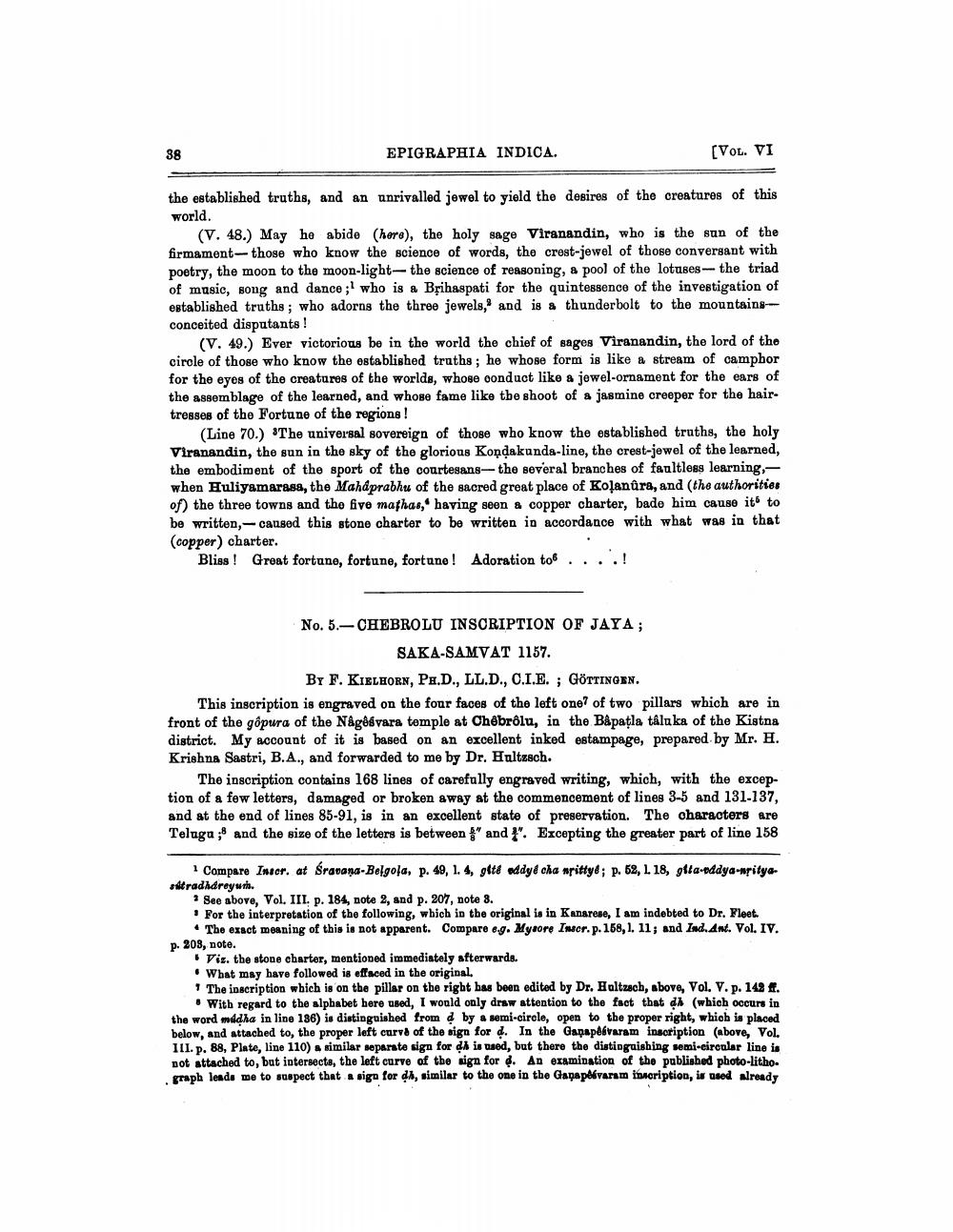________________
38
EPIGRAPHIA INDICA.
[VOL. VI
the established truths, and an unrivalled jewel to yield the desires of the creatures of this world.
(V. 48.) May he abide (here), the holy sage Viranandin, who is the sun of the firmament-those who know the science of words, the crest-jewel of those conversant with poetry, the moon to the moon-light- the science of reasoning, a pool of the lotuses- the triad of music, song and dance; who is a Brihaspati for the quintessence of the investigation of established truths; who adorns the three jewels, and is a thunderbolt to the mountainsconceited disputants!
(V. 49.) Ever victorious be in the world the chief of sages Viranandin, the lord of the circle of those who know the established truths; he whose form is like a stream of camphor for the eyes of the creatures of the worlds, whose conduct like a jewel-ornament for the ears of the assemblage of the learned, and whose fame like the shoot of a jasmine creeper for the hairtresses of the Fortune of the regions!
(Line 70.) The universal sovereign of those who know the established truths, the holy Viranandin, the sun in the sky of the glorious Kondakunda-line, the crest-jewel of the learned, the embodiment of the sport of the courtesans-the several branches of faultless learning, when Huliyamarasa, the Mahaprabhu of the sacred great place of Kolanûra, and (the authorities of) the three towns and the five mathas, having seen a copper charter, bade him cause it to be written, caused this stone charter to be written in accordance with what was in that (copper) charter.
Bliss! Great fortune, fortune, fortune! Adoration to
No. 5.- CHEBROLU INSCRIPTION OF JAYA;
SAKA-SAMVAT 1157.
BY F. KIELHORN, PH.D., LL.D., C.I.E.; GÖTTINGEN.
This inscription is engraved on the four faces of the left one? of two pillars which are in front of the gopura of the Nâgésvara temple at Chêbrôlu, in the Bapatla taluka of the Kistna district. My account of it is based on an excellent inked estampage, prepared by Mr. H. Krishna Sastri, B.A., and forwarded to me by Dr. Hultzsch.
The inscription contains 168 lines of carefully engraved writing, which, with the exception of a few letters, damaged or broken away at the commencement of lines 3-5 and 131-137, and at the end of lines 85-91, is in an excellent state of preservation. The characters are Telugu; and the size of the letters is between " and ". Excepting the greater part of line 158
1 Compare Inser. at Sravana-Belgola, p. 49, 1. 4, gité eddyé cha nrittye; p. 52, 1. 18, gila-vadya-nrityasútradhdreyum.
See above, Vol. III, p. 184, note 2, and p. 207, note 3.
For the interpretation of the following, which in the original is in Kanarese, I am indebted to Dr. Fleet. The exact meaning of this is not apparent. Compare e.g. Mysore Inscr. p. 158,1. 11; and Ind. Ant. Vol. IV. p. 203, note.
6 Viz. the stone charter, mentioned immediately afterwards. What may have followed is effaced in the original.
The inscription which is on the pillar on the right has been edited by Dr. Hultzsch, above, Vol. V. p. 142 ff. • With regard to the alphabet here used, I would only draw attention to the fact that dh (which occurs in the word midha in line 186) is distinguished from d by a semi-circle, open to the proper right, which is placed below, and attached to, the proper left curve of the sign for d. In the Ganapéévaram inscription (above, Vol. III. p. 88, Plate, line 110) a similar separate sign for dh is used, but there the distinguishing semi-circular line is not attached to, but intersects, the left curve of the sign for d. An examination of the published photo-litho graph leads me to suspect that a sign for da, similar to the one in the Ganapéévaram inscription, is used already




